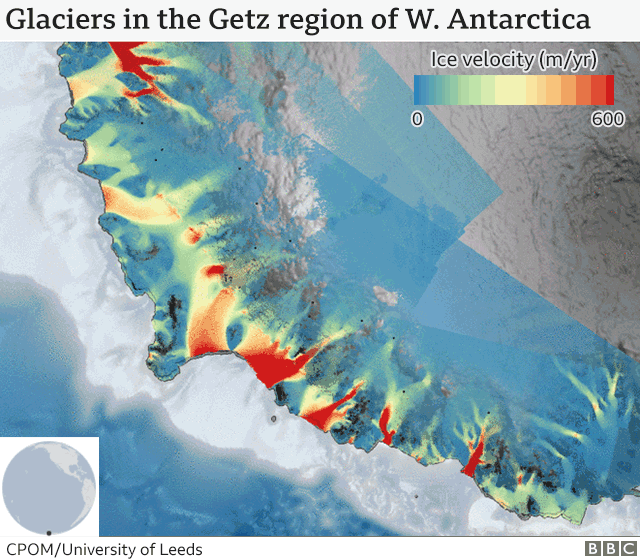Climate change: West Antarctica's Getz glaciers flowing faster
- Published

The glaciers' floating fronts join to form a single, continuous platform, or shelf
Wherever you look in West Antarctica right now, the message is the same: Its marine-terminating glaciers are being melted by warm seawater.
Scientists have just taken a detailed look at the ice streams flowing into the ocean along a 1,000km-stretch of coastline known as the Getz region.
It incorporates 14 glaciers - and they've all speeded up.
Since 1994, they've lost 315 gigatonnes of ice - equivalent to 126 million Olympic swimming pools of water.
If you put this in the context of the Antarctic continent's contribution to global sea-level rise over the same period, Getz accounts for just over 10% of the total - a little under a millimetre.
"This is the first time anyone has done a really detailed study of this area of West Antarctica. It's very inaccessible to people to go and do field work because it's so mountainous; most of it hasn't ever been stepped on by humans," explained Heather Selley, a glaciologist at the Nerc Centre for Polar Observation and Modelling, external at the University of Leeds, UK.
"But it's really important we understand what's going on there - to recognise its glaciers are speeding up and the reason why," she told BBC News.
Selley and colleagues examined two and a half decades of satellite radar data on ice velocity and thickness. To this analysis, they added information about ocean properties immediately offshore of Getz - along with the outputs of a model that put the local climate in context over the period.

The findings, published in the journal Nature Communications, external, reveal an unambiguous linear trend.
On average, the speed of all 14 glaciers in the region increased by almost a quarter between 1994 and 2018, with the velocity of three central glaciers increasing by more than 40%.
One particular ice stream was found to be flowing 391m/year faster in 2018 than it was in 1994 - a 59% increase in just two and a half decades.
The probable cause, once again, is what researchers call "ocean forcing". Relatively warm deep ocean water is getting under the glaciers' floating fronts and melting them from below.
Pierre Dutrieux, a study co-author at British Antarctic Survey, said: "We know that warmer ocean waters are eroding many of West Antarctica's glaciers, and these new observations demonstrate the impact this is having on the Getz region.
"This new data will provide a new perspective of the processes taking place so we can predict future change with more certainty."
Where a line of glaciers pushes out into the sea their floating fronts will often join together to form a single, continuous platform known as an ice shelf. It's interesting to note that in the case of Getz, this platform receives a certain stability from pressing up against eight islands and a number of shallow points on the seabed.
And yet, even with this in-built stability, the feeding glaciers behind are melting and speeding up.
Co-author Anna Hogg, also from Leeds, is an expert in satellite remote-sensing of the polar regions.
She told BBC News: "We have observations now around the whole margins of the Greenland and Antarctic ice sheets in a way we've never had before. We're able to map really detailed, localised patterns of change.
"We're understanding how ocean water is moving around underneath the ice shelf - how and where it's getting in to that cavity under the shelf, so that we can really tie the physical process of ocean forcing to the signal we see in the satellite data."
